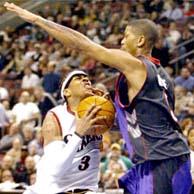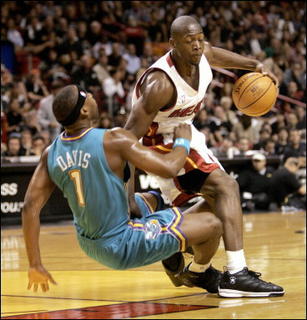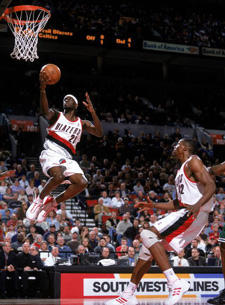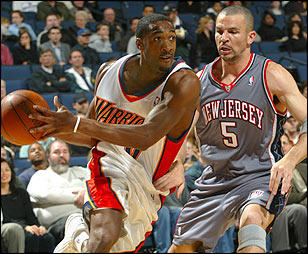The New NBA
This season means more to everyone in the NBA than anyone on the inside is letting on. It’s more than Kobe on his own. It’s more than Lebron getting help. It’s more than Iverson and Webber pairing up to take one last shot at a championship. It’s all of those things together, and it’s more. This season is a gateway, a bridge, between the old generation of players and the new generation and a generation lost somewhere in the middle. For the first time in years, the league is wide open. The Spurs and the Pistons are on top right now, but they’re just barely ahead of a few other teams. Anyone can win a championship this year; anyone can become a star this year. And what happens this year may define the NBA for years to come.

Between the years 1993 and 1997 more than twenty players came into the league that would become the future of the league. They were to be the stars of the future. Names like Allen Iverson, Tim Duncan, Kobe Bryant, Jason Kidd, Antonio McDyess, Chris Webber and Kevin Garnett all came in to redefine what it meant to be an NBA Superstar. Duncan became the consummate superstar. Bryant, the defiant sidekick who only wants to show how good he can be. McDyess went from one of the leagues elite to a role-player. And Garnett, like Kidd, Iverson, Stephon Marbury, Chris Webber, Ray Allen and Jermaine O’Neal have all been elite players who just haven’t been able to take their teams over the top. Nearly all the guys from these classes are still in their prime, but that window of opportunity to achieve greatness on their own terms, leading a team to a championship, is about to close for most of them. Many of their bodies, like Kidd and Iverson’s, have broken down and they’re limited to 60-70 games a season. Many of them, like Garnett and Webber, have contracts that are so big that they’re teams are unable to surround them with quality players. And a few of them, like Duncan, O’Neal and Tracy McGrady, are still in the mix to win championships. The bottom line is only five of the “stars” from these classes, Duncan, Bryant, Rasheed Wallace, Sam Cassell and Glenn Robinson have championship rings, and Cassell and Robinson earned them playing minimal roles for their respective teams. For guys like Webber and Iverson the door may be shut by the end of the season. For Marbury, Allen and Bryant, the door is open for a few years longer, but not if the young guys coming up have too much to say about it. And for Damon Stoudamire, Jalen Rose and Eddie Jones, the door has already, unless a miraculous trade happens, slammed shut and left bruises on their faces as it did. Though a few of these, once deemed “instant stars,” have enjoyed success, largely they’ve served to be nothing more than foils for guys named Duncan, Jordan and Shaq. As soon as this season, the torch could be passed from this generation of NBA star to the next.

And just who’s ready to carry the flame for the newest generation of NBA stars? Look down south to Miami. Dwayne Wade has as good a chance as anyone, in part because he has quite a team to play with including a guy named Shaq, which always helps. Carmelo Anthony is another guy that, if not this year, two or three years down the road, could step up and lead his team to a championship. This years Nuggets squad is as strong as anyone else in the league and they’re deep. And nobody can forget Lebron James. If he’s the next Jordan, then he should be able to win like the man did. Lebron probably won’t be able to do it this year, but stranger things have happened. Also, you can’t for a minute count out Ben Gordon, Andrei Kirilenko, Gilbert Arenas or Pau Gasol from putting one of yesteryear’s big guns out of the first round of the playoffs. The new generation of stars is ready to step up, and this could be the year that they exert their dominance over the league.

This could also be the year that the NBA’s lost generation, the draft class of 2000, is either found, or lost forever. Although at lot of the best players that could have come from this class were selected a few years earlier, directly out of high school, this class still held some promise. When he’s healthy, Kenyon Martin is almost a superstar. The same can be said for Michael Redd. But beyond that, this class is one that was largely a huge disappointment. That is, unless Jamal Crawford, Quentin Richardson, Darius Miles, Jamal Maglore, Stromile Swift and Mike Miller can live up to all that potential that people talked about them having in 2000. Not that all these guys are going to step up and become stars, but if one or two can make that transition this year, the class won’t have been a complete bust. If they can’t, then that is the fate of this draft class. They will wither into role players on benches all over the NBA. A few will be lucky enough to play with people from later draft classes and will win rings, but largely, the draft class will be forgotten. That’s why it’s so imperative that Craw and Q listen to Larry Brown; that Darius Miles learns how hit a jump shot. They are the guys from this class that were expected to make a difference, and thus far, they haven’t. Now the time has come for them to play ball or be forgotten.

With the new bargaining agreement ushering in a new era of peace between the owners and the players, the winds of change may be blowing and may blow out some dead leaves. The NBA’s future may become the NBA’s right now while the past slowly fades into obscurity. Whatever happens, this season is a chance for the young and the old to define themselves and their roles in the future of what can be called, the new NBA.

1 Comments:
Michael Jordan entered the league in 1984 with the Chicago Bulls, providing an even more popular star to support growing interest in the league. This resulted in more cities demanding teams of their own. In 1980, 1988, and 1989, five cities got their wishes as the Dallas Mavericks, Charlotte Hornets, Miami Heat, Orlando Magic, and Minnesota Timberwolves made their NBA debuts. The 1992 Olympic basketball Dream Team, the first to use current NBA stars, featured Michael Jordan, Larry Bird, and Magic Johnson. In 1995, the NBA expanded to Canada and to 29 teams with the Toronto Raptors and the Vancouver Grizzlies. In 2001, the Vancouver Grizzlies were relocated to Memphis, which left the Toronto Raptors as the only Canadian team in the NBA. Globalization also occurred in the 1990s. A growing number of NBA star players also began coming from other countries. sportsbook, Initially, many of these players, such as 1994 NBA MVP Hakeem Olajuwon of Nigeria, first played NCAA basketball to enhance their skills. In 1996, the NBA created a women's league, the Women's National Basketball Association (WNBA). In 1998, the NBA owners began a lockout which lasted 191 days and was settled on January 18, 1999. As a result of this lockout the 1998-99 NBA season was reduced from 82 to 50 games (60%), which were all played in 1999 only, thus calling it the 1999 NBA season. San Antonio won the championship on June 25th by beating New York Knicks. http://www.enterbet.com
Post a Comment
<< Home